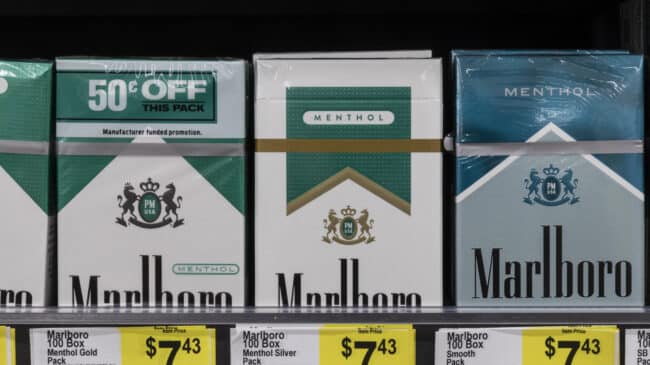The U.S. Food and Drug Administration is planning to ban menthol cigarettes. The ban is a high-risk public health strategy that is expected to spur the growth of black markets, lead to more incarceration, and undermine some of the criminal justice reforms the country has made in recent years. Nevertheless, advocates of banning menthol cigarettes would view the trade-offs as worthwhile if the gains for public health turned out to be large enough. But it is worth examining how realistic it is that the United States would actually significantly improve public health by banning menthols and whether there are other ways to achieve similar gains short of prohibition.
Case Studies
The most optimistic case study for the prohibition of menthols comes from Canada. According to a study of Canada’s menthol ban, while the vast majority continued to smoke after the ban was implemented, a significant portion reported quitting. The study found “59.1 percent of pre-ban menthol smokers switched to non-menthol cigarettes; 21.5 percent quit smoking and 19.5 percent still smoked menthols, primarily purchased from First Nations reserves.” These results might seem somewhat underwhelming but are still impactful. But when we compare the menthol smokers to non-menthol smokers, we see a lackluster result.
According to the authors of the study, menthol smokers increased their attempts to quit smoking, relative to non-menthol smokers by 9.7 percent. However, overall, just 7.5 percent more menthol smokers quit compared to non-menthol. It is also unclear whether menthol smokers from before the ban had more quit attempts than regular smokers.
The study notes that between its baseline and follow-up, “[M]enthol smokers did not differ significantly from non-menthol in quit success.” Compared to the U.S., menthol was also just a small part of the Canadian cigarette market, accounting for five percent of Canadian sales compared to menthol products accounting for roughly one-third of cigarette sales in the United States.
The European Union, with its 27 member states and a population of about 450 million, is the largest region to have banned menthol cigarettes. Menthols were already unpopular in Europe. Poland had the largest menthol market in the European Union at 28 percent, closest to America’s market at 36 percent. A preprint study funded by the Norwegian Cancer Society in partnership with the Polish Health Ministry found no statistically significant change in cigarette sales after the ban. While the EU suffers from illicit trade in menthol cigarettes and most smokers switched to equally unhealthy non-menthol cigarettes, entrepreneurs have also stepped in to offer smokers ways to adulterate regular cigarettes to give them a menthol flavor.
After the ban in the EU, a study of young Danish smokers found that many were still smoking menthols, 20 percent after the ban compared to 29 percent before. One reason is this proliferation of flavor accessories that can effectively give a menthol flavor to non-menthol cigarettes. Alex Liber, the author of the previously mentioned Polish study and a continued supporter of a menthol product ban said of the Danish research: “My takeaway is that any government that moves forward with a menthol ban should temper its expectations on immediate consumption declines. Tobacco companies will protect their cigarette cash cow.”
Massachusetts is the only state in the US to have implemented a ban on flavored tobacco products as of this writing. One result of Massachusetts’ ban has been a dramatic increase in purchases of non-menthol cigarettes and an increase in the sales of menthol cigarettes in New Hampshire and other neighboring states. According to the Tax Foundation, the ban cost Massachusetts $125 million in lost tax revenue in its first fiscal year. In addition, a forthcoming Reason Foundation analysis finds the region in and around Massachusetts experienced a net increase in cigarette sales of 7.2 million packs.
In the aggregate, the experience of menthol bans in the real world, as opposed to forecasts about them, is that the bans have minimal effects on tobacco consumption but do engender unintended consequences, even in markets where menthol is relatively unpopular.
A Harm Reduction Alternative to Bans
Banning menthol cigarettes, a product used by up to 18 million Americans, is a radical policy with significant implications for the criminal justice system and personal autonomy. It is worth examining whether less intrusive, costly, or iniquitous measures can help those who wish to quit smoking.
Smoking rates have gradually declined over the last few decades. And they have declined faster since safer nicotine alternatives like e-cigarettes were introduced.
One reason why so many Americans keep smoking traditional cigarettes is that public health officials have mostly failed to let them know that nicotine alternatives like e-cigarettes are substantially safer than combustible cigarettes. According to the Health Information National Trends Survey, just 2.6 percent of adults correctly believe e-cigarettes are much less harmful than traditional cigarettes.
Since there is no burning tobacco in e-cigarette products, they are substantially safer than traditional cigarettes. Research also shows e-cigarettes are far more effective than nicotine replacement therapies at helping smokers quit.
However, thus far, the FDA has only authorized a handful of e-cigarette products as “appropriate for the protection of public health.” But the most popular vaping products among consumers have been banned or are in regulatory limbo.
The FDA has also taken no action to correct public misperceptions around e-cigarettes or other products like nicotine pouches or snus. Correcting these misperceptions and ensuring a wide range of appealing alternatives to cigarettes could help rapidly decrease smoking rates without imposing the negative consequences and costs of prohibition.
Rather than resorting to the failed policies of the past, the FDA and the Biden administration should apply the harm reduction model to tobacco policy. Educating the public and taking a harm reduction approach has been successful in the fields of sexual health and drug addiction, and it would be far more effective in reducing smoking than banning menthols.

